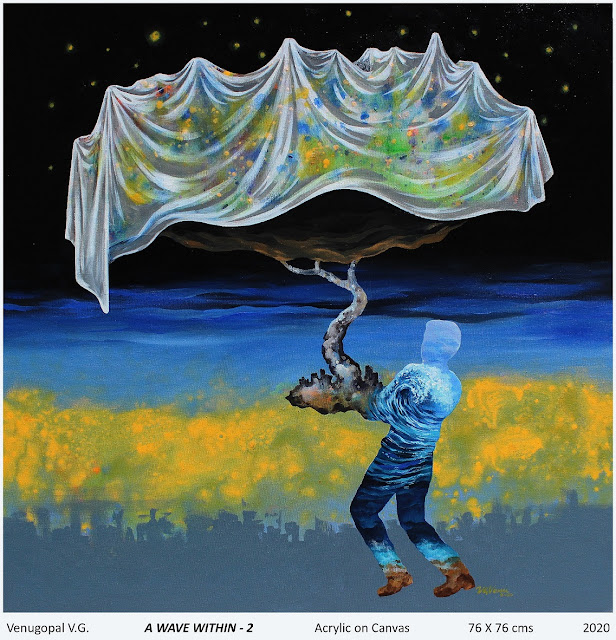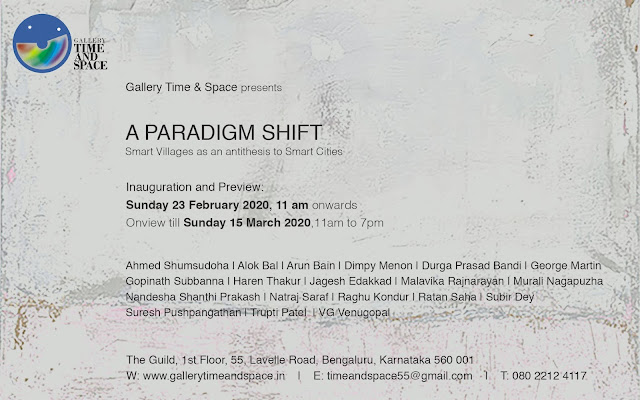vgvenu
Sunday, October 11, 2020
Soliloquies curated by Aditi Ghildiyal
Anant Art, New Delhi
'Soliloquies: in the season of Quarantine' was a special curatorial initiative by Anant Art in the times of quarantine and social distancing; a situation that punctuates human life expansively and thus, connects us more than we reckon. A ‘soliloquy’, contextualized as an artistic practice and expression in recluse underscores an artist’s imagination. The works delve into the relevance of art as a necessity and beyond the constructs of an essential ‘market’, owing to its therapeutic and enabling effect.
A Paradigm Shift
Gallery Time & Space, Bangalore
India has a “tryst with destiny” since its inception. Freedom at midnight literally pushed this new country into a headlong fight with the reality of the world. Many governments have come and gone since India became an independent nation, but still the actual citizen of the country who is far removed from any urban center, has always doubted the efficiency of the deliverables promised to them by their elected representatives. Progress and development still remains a utopian dream to a vast majority, as the situation remains the same. The reasons for this are innumerable, but its repercussions have slowly and subtly shifted the focus of progress and development from rural areas to urban centers. Urban centers are hailed as the future hubs of the nation. They are seen as a driving force of the nation, but this very stance has given rise to many further complicated issues. Mass migrations from the rural areas have put a tremendous toll on the natural resources of our country. Unplanned growth of the cities, irresponsible handling of resources & pollution has affected every major urban settlement in India. Times have changed, and now everything seems to be fast, everyone is ‘connected’ in today’s context. But still this ‘gap’ between rural living and urban living defines who we are. The aspirations of the populous are all towards the glittery life which the urban centers have to offer. After we have successfully succumbed to the internet revolution, this has gone even a step ahead, and we are all a citizens (or a Netizen) of a ‘global village’. Mahatma Gandhi said “India lives through its villages”. He had a strong belief that ‘Gram Swaraj’ was the crucial element which would rebuild this country into a strong economy. But sadly Gandhi’s Ideas remained only as an inspirational text, where as India is trying to re-model itself into a developed economy. It is in this context that the question of this ‘gap’ emerges hauntingly. Today more stress is being put upon developing ‘Smart Cities’. In these times of erosion of natural resources, it is a big shift in the way in which we are planning the future of this country. It will change the dynamics of our societies to a great extent if we continue along this path in a careless way. Mass exodus towards the cities is still a phenomenon now as the aspirations which people crave for are still ostensibly provided by the cities and not by villages. At the same time the government’s so called focus or shift towards ‘smart cities’ has added to the problem instead of addressing the issue at large. There have been some attempts to address this issue but given the scale of the problem, it is still a growing concern. This proposition of smart villages as an antithesis to the idea of smart cities is an attempt to ignite a spark, which can inspire a thought, aiming to influence the way in which the ‘gap’ of the urban versus the rural can be bridged. This artistic intervention is not aiming towards propagating a solution; rather inspire a possibility of change within our human conditions. At this juncture, this artistic intervention would stand as a symbolic representation of a way of life which could be a collaborative effort between the rural population and urban know-how. This would be a very responsible stance and a position which is urgently required in today’s context. It also hopes to dwell within various factors and issues which have been a liability within the rural framework. This attempt will enable citizens to question, contemplate and comment on the urban impositions on a rural backdrop, where changing times have eroded the selfsustained lifestyle of villages as well as put at risk the much needed agricultural way of life which serves as an antidote to the growing ecological imbalance. When one thinks in the context of relooking at this issue of erasure’s of lifestyles, lived experiences, sub cultures and society in general, Gauguin’s title of one of his monumental painting “Where do we come from, who are we, where are we going (1898)” stands as an epitaph through which hope emanates from within. His title refers to the philosophical roots of our existence, and it stands as a strong denominator which represents our dilemma from within our human conditions. Through time humanity is losing its innocence and is becoming volatile and selfish towards nature. This is a phenomenon which can be seen in most of the developing countries today, and in India we are living in the crux of it. This artistic intervention aims to represent those hopes and wishes for a wholesome sustainable future. It hopes to question existing practices and conditions which have been corroding our lives; it aims at tracing that virtue which has been put aside by irresponsible lifestyles. Its intention is to put forward that which can inspire a possibility towards a new horizon.
Text: Pradeep Kambathalli
Friday, February 2, 2018
Reimagining: (Un)Reality and Space curated by Nalini S Malaviya @ YepArt, Bangalore
Reimagining: (Un)Reality and Space
Featuring:
Debraj Goswami
Kalyan S Rathore
Maripelly Praveen Goud
Muktinath Mondal
Murali Cheeroth
V G Venugopal
Observation, truth and materiality interweave to create alternative realities that occupy a realm which is corporeal, yet fictitious, clouding lines of physicality of dimensions. The plurality inherent in existing and functioning within these coordinates, challenge and inspire individuals to explore the intrinsic harmony and conflict embedded in such systems, and simultaneously imagine new spaces. Notions of identity and placement amidst variables construct fresh associations and connotations, where the resulting topography is a visually enriching landscape capturing points of dissonance and accord, shifts in reality, and reimagined spaces.
The curatorial endeavour ‘Reimagining: (Un)Reality and Space’ attempts to explore this conceptual premise through the works of a select group of artists and to take a closer look at their practice, in response to and within the physical and metaphorical space which they occupy and sustain in their art making.
Featuring:
Debraj Goswami
Kalyan S Rathore
Maripelly Praveen Goud
Muktinath Mondal
Murali Cheeroth
V G Venugopal
Observation, truth and materiality interweave to create alternative realities that occupy a realm which is corporeal, yet fictitious, clouding lines of physicality of dimensions. The plurality inherent in existing and functioning within these coordinates, challenge and inspire individuals to explore the intrinsic harmony and conflict embedded in such systems, and simultaneously imagine new spaces. Notions of identity and placement amidst variables construct fresh associations and connotations, where the resulting topography is a visually enriching landscape capturing points of dissonance and accord, shifts in reality, and reimagined spaces.
The curatorial endeavour ‘Reimagining: (Un)Reality and Space’ attempts to explore this conceptual premise through the works of a select group of artists and to take a closer look at their practice, in response to and within the physical and metaphorical space which they occupy and sustain in their art making.
Nalini S Malaviya
Art Consultant and Writer
Subscribe to:
Comments (Atom)





































